This site uses cookies so that we can provide you with the best possible user experience. Cookie information is stored in your browser and performs functions such as recognizing you when you return to our website and helping our team understand which sections of the site you find most interesting and useful.
Interview for VIUZ, the first daily news about digital marketing
Read this article here and find out more about VIUZ
80% of users plan their in-store purchases online. They do use search engines, web sites, and shop-bots, and are also influenced by digital advertising. Advertising plays a key role in gathering information whether it is ad banners or emailing. For those involved in web-to-store, the equation resides in their capacity of linking a centralized communication strategy operated by the brand to the reality of business on a local scale. Back to 5 decisive steps
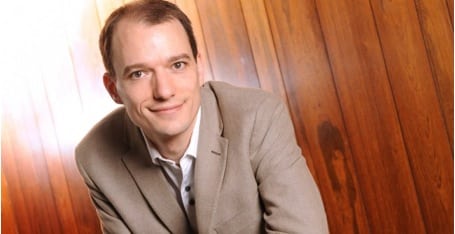
Interview of Pierre-Antoine Durgeat, president of ADventori
1- A new balance between brands, distributors, franchisors and franchisees
An evidence-informed approach of its sales network must be taken with a web-to-store oriented communication strategy by the brand. It is to show its network that the integration strategy of its physical products in e-commerce ambitions is sincere.
In other words, a brand can drive and control its business strategy from end to end by: adding value to some networks, enhancing its regional presence, boosting up its network sell-in and helping stores sales.
In practice, this means applying to digital a DRP (Daily Regional Press) or outdoor ad communication strategy:
- By putting the distributor’s name up in the banner,
- By assisting them in disposing of stocks and showing prices,
- By making them proud to be seen on a media they helped purchase vs asking them to pay a fee to the show business star representing the brand at the national level… even glamour business stays business.
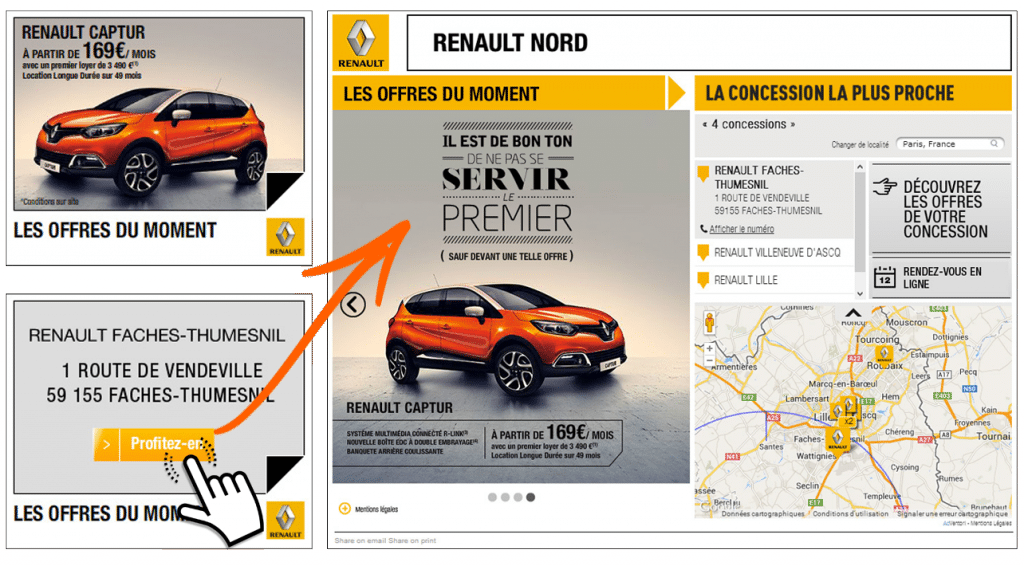
Renault operates destocking campaigns on an ultra-local scale, as well as more and more qualified lead test drive campaigns, which are directly transferred into their CRM. These campaigns orchestrated by ADventori are 100% financed by the Regional authorities, i.e. the dealers. The objectives are purely web-to-store and fit in a publicity campaign context. Throughout the three years that we’ve supported them, we’ve nurtured their technology to accompany their strategy.
Brands are now able to directly generate business, and the advertising speech is no longer confined to branding.
2- Advertising : new exploitation canal for Yield management
Most commonly, a brand will highlight in its products, services, or identity in its communication. Often, this communication is accompanied by Legal Notice “From this date or that price”, nothing precise really, just an invitation to discover. But customizing digital messages brings much more than just precision: it keeps it real.
For most brands, and this is especially true in Tourism, the Yield function is strategic. It requires rational advertising campaigns which require no more alignment between the business objectives and the brand.
To this end for precision, integrating real-time advertisers feeds is crucial: the price of the actual dates, a specific stock. However, this information isn’t neutral: it weighs in the purchase decision, on one hand, and in the sales / profitability ratio, on the other hand.
At this point, we’re talking real world immersion in advertising: this is the real price, of the real product that is communicated to the user… it’s the death of “From…“ which can undermine an offer greatly.
At IDTGV they have fully comprehended the immediate impact of this integration: we are connected to their booking center. Retargeting banners customized by ADventori are henceforth capable of orienting sales towards a half-empty train with attractive prices, or towards a more profitable destination. Our technology has also allowed us to adjust the legal notice to the offered route.
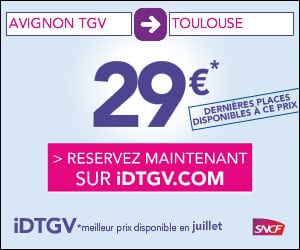
The same approach is used for local shops: the product is integrated locally, with a price, and real-time stock offered by local shopkeepers. The Fashion industry will benefit in turn from these flows integrations in their national ads.
According to the optimization needs, advertising adapts offer to demand in real time, Keynes 2.0, in short.
3- Targeting the Purchase Cycle
Consumption patterns have changed: online data search, blogs consultation and brands sites have taken a major place, and now allow consumers to avoid to go to Points of Sales at the upstream stage of their purchase cycle.
The model is no longer binary: brand upstream, downstream distributor. Today brands and distributors must communicate all throughout this purchase cycle.
In global communication, the web-to-store brick can conquer the last meter by addressing individuals according to their purchase decision’s maturity.
For this, a brand must play on three levels :
- Customizing advertisements
- Adapting the level of information that’s developped
- And staging its campaigns.
Each typology of products has a purchase cycle: we know one month is needed to buy a TV, 4 to 6 months for a car… At the final stage of the purchase cycle, communicating the nearest Point of Sales to the user is decisive.
Also, a retargeting campaign should in the end take the user to the front door of a shop if an online purchase wasn’t satisfactory.
Thanks to ADventori, Auchan Drive leads their campaigns thoroughly by this principle: involve their users by giving them the nearest drive-in and adding a promotional code.

4- Real Time, here, there and now!
To lift the ultimate brakes on purchase, the brand, its network and its buyers must be physically reconnected. And thus our compulsive needs to buy and to possess « everything » and « now » shall be met. And since these needs get stronger when we’re on the move … they must be sated by any device.
And with Real-Time media purchase being generalized, the necessity to connect real-time messages to it meets the challenge.
How ? By injecting advertisers’ real flows into their creative, and mix them up to any kind of flows that may help the user’s commitment: that is how Price+Product+Geoloc+Weather is an explosive combo for all in-store sales. Real-Time Marketing must be respectfully applied throughout all of its aspects (media purchase, message, information).
In the real-estate business, for companies like Immo-Neuf or Nexity, ADventori presented internet users with local goods at corresponding prices by managing their click in a differentiated manner: offers pertinence is increased, Internet Users’ commitment is duplicated.
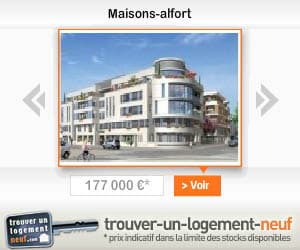
5- National advertising: Speaking the user’s language
This step meets the user’s needs, whereas the 4 previous ones met brands’ goals. It is then the essential point… finally. Including data in a banner is imperative, but making it accessible to those looking at it is decisive. Everyone is sensitive to arguments of proximity, to accuracy : when a banner gives you the product, the price, the address…. all this information will waken the user’s commitment… and will prevent them from online searching… when their search will eventually lead them to competitive offers ! Digital messages customization for web-to-store forms primarily a more efficient conversion funnel.
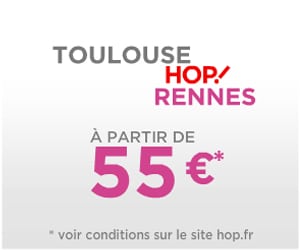
When ads speak the user’s language, it’s a bonus for brand awareness. We observed it on the HOP! launch campaign, when they saw departure flight prices at the closest airport, not only users from Castres knew they could go directly to Rennes departing from Toulouse (no stop at Paris), but also that HOP! allowed them to do so.
In summary, based on the flows of accurate data that will allow digital messages customization, a brand will be able to take action in web-to-store regardless of its branding strategy and cover the 5 following points:
- Unification of its business policy
- Levering its Yield Management policy
- Keeping internet users in the brand’s world all throughout the purchase cycle
- Leading a Real-Time Marketing approach from start to finish
- Bringing back proximity between brand, network and buyers
Pierre-Antoine DURGEAT
Co-founder and technical architect of innovative start-ups (visiocity, mappy.com, cafe.com, dismoiou.fr), Pierre-Antoine is a serial entrepreneur, an investor and a designer of tomorrow’s web and mobile platforms.
